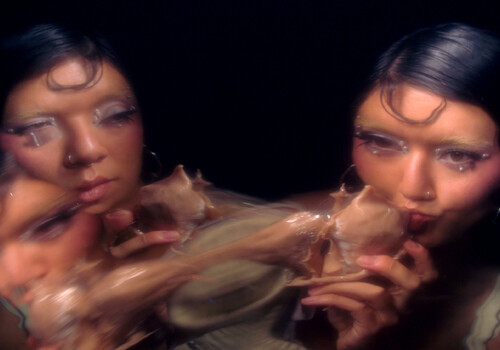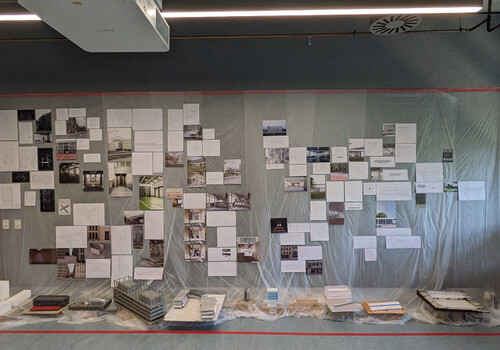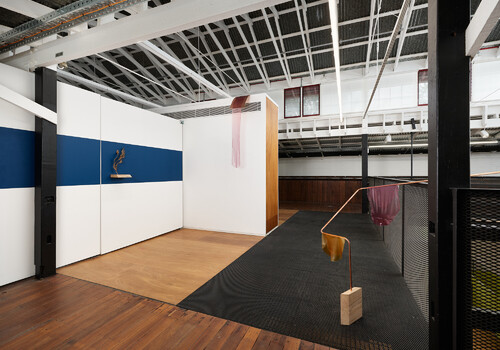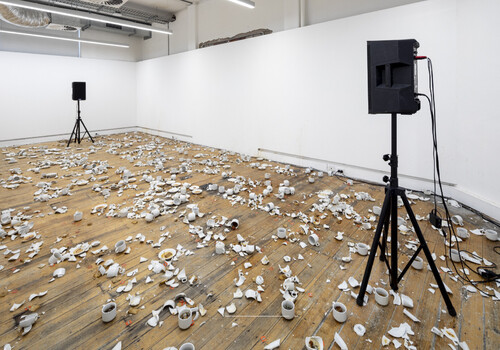Photography, Queensland College of Art
By Cassius Owczarek
Why do we keep so much of ourselves hidden from the world? Whether it be inner demons or memories, it seems as if we obscure so much of our self-identity within ourselves. The photographers in QCAD’s recent graduate exhibition bring those elements to life, exploring ideas of psychological and ontological obscurity.

Sam Keeble, The Insignificant, 2024, Photographic Print on Lustre Paper, various sizes, Brisbane. Photo: Cassius Owczarek.
First, winding up the stairs to the white box, Trace, is a combination of six student works that aim to uncover forgotten moments and buried elements of our past. The audience is guided seamlessly through the space with linear displays of the art, broken up by minimal seating and sculpture works in the centre. Perhaps what takes the eye most is Mia Clayton’s Boom or Bust, a burst of natural colours in the corner of the room. One feels as if they are pushing through the foliage of Tasmanian rain forest as they walk beneath fabric hangs of Clayton’s photography. The project depicts a hike she undertook with her father to unlock the stories of her heritage, and her grandfather’s work on the Tasmanian railway. The spectacular film reel video feels as if it has been dug up from boxes of old family memorabilia. Tying in nicely to the adjacent display, Jade Furgson’s What Little Remains presents still images and museum-style displays of what is left behind from the past. Liminal space is used to hold that sense of emptiness in loss—a tactic echoed in Maverick Suljic’s Lost and Found on the opposite wall, a series of collage works showing the little bits of life that form who we are.

Mia Clayton, Boom and Bust, 2024, Mixed Media, various sizes, taken in Tasmania film developed and displayed in Brisbane. Photo: Cassius Owczarek
However, not all our memories are fond. Kavya De Silva shows us this in her tea-stained tracings of Made in Cylon (2024), which separates the identity of her subjects from the original photos, instead showing only their faceless outlines. Sarees are draped between the images, maintaining a tether to identity. Confronting the brutal history of women’s working rights in Sri Lanka, the project engages with the exploitation of tea as export while showing what is often taken for granted. Similar thematics emerge in the cluttered display of Sam Keeble’s collection of photographs The Insignificant (2024), where often overlooked domestic objects and homeware like Christmas lights and fruit bowls seemingly point to parts of us that may also go forgotten.

Overarching room shot featuring works by Katya De Silva, Larry Li and Jade Ferguson, Photographic Series, various sizes, Brisbane. Photo: sourced from QCAD official photography
This sense of home shifts in the voyeuristic design of Unmasking the Vessel, the second portion of QCAD’s photography exhibit. This intimate environment is filled with comfy chairs, fake flowers, and imagery of femininity and sexuality. A flow of cyanotype works between Ash E’s Growing Sideways and Luna Cat’s Polymorphous Desires testify to the fluidity of sexuality. Luna Cat shows themselves with their lovers intertwined, confronting ideas about “traditional” relationships. And if one chooses to venture around the print, there is video of the three together, as if one has stumbled into their space: a powerful use of exhibition layout encouraging reconsiderations of standards of love and loyalty.

Luna Cat, Polymorphous Desire, Cyanotype on Silk and Video Projection, 1800x1800mm, Brisbane. Photo: Cassius Owczarek

Overarching shot featuring works by Taylaa Bailey, Spot Willows and Luna Cat, 2024, various dimensions, Brisbane. Photo: QCAD official photographer
Ideas about selfhood and body are also seen in Taylaa Bailey’s FORMS/UNBOUND and Spot Willows’s She Named Herself Spot Willows, which complicates a relationship with self, and Azora Photography’s reflection on femininity. All use bold displays of form that contort and manipulate the body. Whether through obscure sculpture, rough landscape or neon technicolour, these artists uncover the obscurities of identity, suggesting that not everything is as soft and comfortable as it may initially appear.
Cassius Owczarek (@saturn.ii.dae) is a Meanjin based artist and writer, with a major focus on identity and socio-political themed work. Moving from his small town in rural Queensland and promptly coming out as trans Cassius has a passion for the parts of ourselves, we hide away, what we show the world and how the world affects us. His work, both in art and writing, tends to focus on identity politics.









































